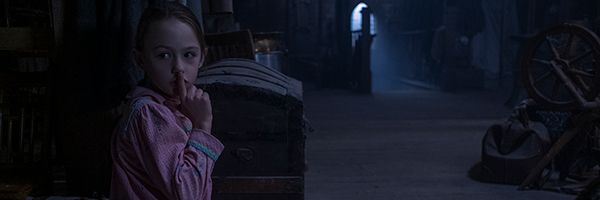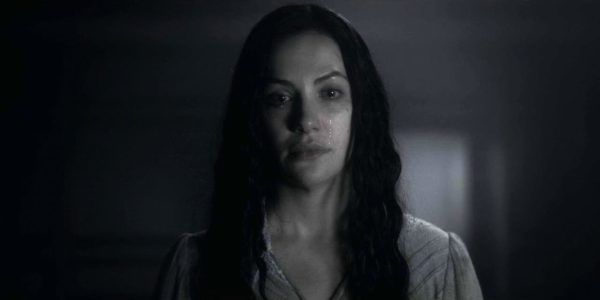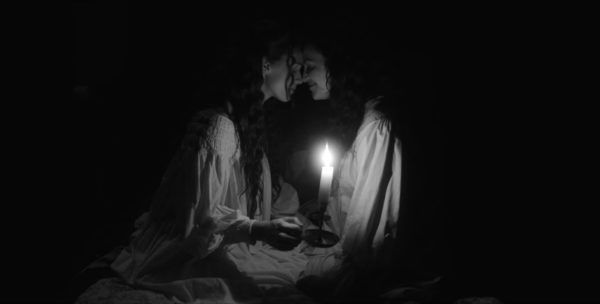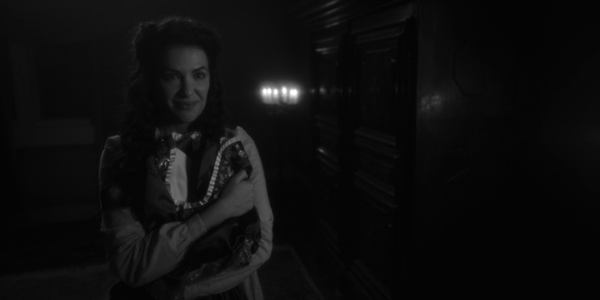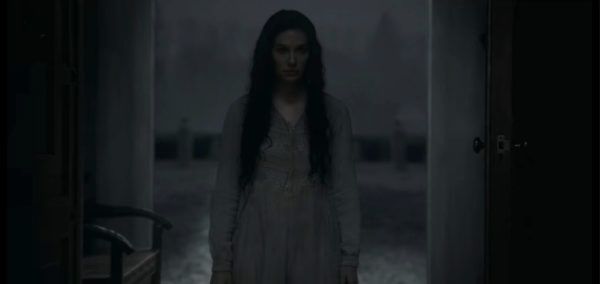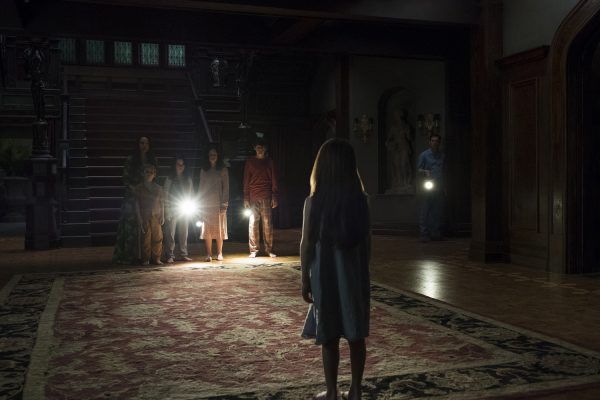[Editor's note: The following contains spoilers for The Haunting of Bly Manor Episode 8.]
If there’s one small complaint fans of The Haunting of Hill House had about that brilliant and terrifying Netflix series, it was that the show largely left the backstories of the ghosts at Hill House ambiguous at best and unexplained at worst. When it came to crafting the 1980s-set follow-up series The Haunting of Bly Manor – with an all new story, setting and characters – showrunner Mike Flanagan wasn’t going to make the same mistake twice. In fact, Flanagan revealed in a roundtable interview with Collider and other reporters that he and his team intended to delve into the histories of the Hill House ghosts in that show, but they ran out of money. And that idea directly inspired Bly Manor Episode 8, which is a stunning hour of television.
Indeed, the penultimate episode of The Haunting of Bly Manor flashes way back at the titular mansion to tell the tragic backstory of the Lady in the Lake, who we come to learn was once a woman of stature named Viola. The entirety of Episode 8 takes place in the middle of the 17th century and chronicles how Viola (Kate Siegel) and her younger sister Perdita (Catherine Parker) were orphaned when their father died, but thanks to Viola’s craftiness they secured a future for Bly Manor by wooing wealthy suitor Arthur Floyd, who married Viola. She was seized by a restlessness after her wedding, and shortly thereafter gave birth to a daughter Isabelle who she dearly loved.
Unfortunately, Viola became sick with “the lung” and was forced to quarantine from her family. On her death bed she refused to say her Last Rites, with her sister encouraging her. “God should know better, she is as he made her,” Perdita said at her bedside. “She says she will not go, she will not.” And she didn’t. Viola did not die, but was never quite healthy either. She grew jealous as her husband, sister, and daughter lived their lives; grew bitter as she watched Perdita fawn over Arthur. In her final days, Viola locked away her precious jewels and dresses, making Arthur promise her he would save them for when their daughter grew old enough to wear them.
One night shortly thereafter, Perdita – weary and angry – smothered her sister to death, finally putting an end to her misery, and to the constant emotional abuse Perdita suffered from Viola. After her death, Viola found herself locked in her bedroom, waiting for the day her daughter would open the trunk of dresses. When the door finally opened, however, it wasn’t Isabelle but instead Perdita, who stole the keys and unlocked the trunk against her now-husband Arthur’s wishes. Upon holding up a dress, Perdita was swiftly strangled to death by her sister from beyond the grave.
After the murder, Viola tucked herself back away inside the trunk, content with spending the rest of eternity near her beloved husband and daughter. Except, when Arthur decided to sell Bly Manor and move away with Isabell, he threw the trunk into the lake believing it to be cursed. “This absolute abandonment shattered Viola’s heart,” the Narrator explains during the episode. “The feeling of being pulled towards some other place, some realm beyond, had faded in the years since her death, but now she rejected it outright. With every ounce of her considerable will. As when she was sick and against all probability, Viola would not go.”
So she slept, she woke, she walked. She would rise out of the lake and walk up into her old bedroom, “feeling that if she walked to her bedroom, to the room she once shared with her husband, her infant daughter, that perhaps the nightmare would abate,” the Narrator explains. But each time she faced an empty bed, she would remember. And the remembering itself “was injury anew.”
Viola happened upon people during her walks – a plague doctor when the house was being used as quarantine, a vicar who was trying to perform an exorcism, even a young child sleeping alone in the bed. She killed each one, but the gravity of Viola’s refusal to leave kept anyone who was killed at Bly Manor there. A ghost. But the longer they were there, the more they would fade – physically and mentally. Until we get to the Lady in the Lake we see in 1987, with no face but a determination to drag whatever she finds down into the lake with her.
The Haunting of Bly Manor Episode 8 is an origin story not only for the Lady in the Lake, but for all the ghosts we see throughout the series. And this idea, Flanagan revealed during our group interview, was borne out of not being able to tell the backstories of the Hill House ghosts during that first season:
“In Hill House, we had intended to do a full history of the Hill family and of the residents of Hill House prior to the Crains moving in. We didn't get to do it. We had written it, we had cast it, we had scheduled it, it got excised before we could shoot it as we struggled to try to get the season done on time and on budget. That was the thing that we sacrificed on the altar of our good behavior, but the idea for this that we could actually go back and tell the story of The Haunting itself and of the ghosts so that they weren't so hard to kind of connect to our protagonists. That was really exciting. It was like this time, we can actually go back, we can do a proper period piece. We have this beautiful piece of material. It seemed like such a great opportunity for Cate (Catherine Parker) and for Katie [Siegel], both of whom we couldn't find kind of an overarching series regular role for in the story as it was structured.”
Flanagan revealed that Episode 8 is his favorite of the Bly Manor batch, and went on to discuss how the episode works as an adaptation of the Henry James short story The Romance of Certain Old Clothes, which itself inspired a whole bevy of modern horror movies:
“That episode is my favorite this season. The short story The Romance of Certain Old Clothes, other than having I think the best title of any short ghost story I've ever heard, in it I thought were the seeds of so many things that have become embedded in contemporary horror. You read the story as it is and you can see kind of the inspirations for The Ring and for The Grudge. You see this example of supernatural revenge imagined, it's so beautifully described in the book that they find the poor woman splayed out in front of the trunk with this frozen expression of horror on her face and the bruises of the fingers around her neck from the ghost that strangled her. And not only is that more aggressive and vicious than anything else Henry James ever wrote about a ghost, most of his ghosts are like incredibly polite and they just kind of like, ‘Oh, hello.’ That was fantastic. But to me, it really shows how some of the ideas Henry James first put out there have caught on either consciously or subconsciously over the years and have continued to inform the genre. That story was always going to be one of the crown jewels of this season.”
The Doctor Sleep filmmaker said they always intended for Episode 8 to be an homage to classic horror cinema, as evidenced by its black and white aesthetic:
“This was such a wonderful chance to bring back [Cate and Katie] and to be able to say, we're going to dig into this, we're going to look at The Innocents. We're going to look at The Haunting. We're going to look at classic black and white horror and we're going to try to make this a love letter to an era of cinema that, much like Henry James, the short story is still influencing work today. That comes from a time when it was about atmosphere and dread and character development and not about jump scares and gore and special effects. It really is kind of the collision of a lot of the things that are the most important to us and Axelle Carolyn, who directed that episode, is also a student of classic black and white horror cinema and came to it with so many exciting ideas of how she wanted to tell it when it came to the costume design for that episode, which was this juggernaut compared to the rest of the season.
I mean how exciting that was for [costume designer] Lynn Falconer and for [Siegel and Parker], kind of everybody was always looking at Episode 8 as our chance to do what we love the most and what made us want to do The Haunting at all, which is to kind of look back at Robert Wise and Jack Clayton and those incredibly influential movies from the early '60s, which were done so perfectly they've rendered it pointless to try to do a faithful feature adaptation of these texts.”
Indeed, Bly Manor isn’t as “scary” as Hill House is, but it’s not trying to be. It’s a Gothic romance, and Episode 8 takes that up a notch with a period setting, gorgeous costumes, and horror borne out of emotion and longing and turmoil instead of jump scares or gore. In that way, it’s a triumph.
Flanagan compared Episode 8 to the “Two Storms” episode of Hill House – the one made up of long unbroken takes – and revealed they shot it last:
“It was one of those episodes, much like Episode 6 in Season 1, that we were preparing for and building up to the entire time. We shot it last. We had finished our A story and made it all the way to the end, and then we had to redress everything, redress the interior of the house, the exterior of the house, get rid of all the electric light fixtures, put in all the candle sconces, completely change everything over and just got to kind of finish the experience of making the season with this beautiful kind of stand-alone truly kind of Gothic romantic black and white period piece, which hopefully we wanted to pull everything else together to give us a satisfying mythology for our monster and for our ghost that also helped humanize her.”
Episode 8 is crucial not just for the mythology of Bly Manor, but for the emotional themes of the story. It’s a story about love in its many forms, and the ghosts that arise from lost love. The monster of the season is a woman whose life was taken from her, and then who was abandoned in the afterlife by her husband and child. The pain of being reminded every time she goes to the bedroom that her child and husband are not there is all-encompassing – she’s a walking open wound that refuses to scab over. And while she’s terrifying to be sure, flashing back to tell her story brings an added humanity and tragedy to the events of the finale.
For more from our interview with Flanagan, click on the links below. Look for the full interview on Collider soon.
- Mike Flanagan on the Heartbreaking 'Bly Manor' Finale and If That's Dani's Hand
- 'The Haunting of Bly Manor' Dream Hopping Explained by Showrunner
- 'The Haunting of Bly Manor' Showrunner on Those Hidden Ghosts
Adam Chitwood is the Managing Editor for Collider. You can follow him on Twitter @adamchitwood.

